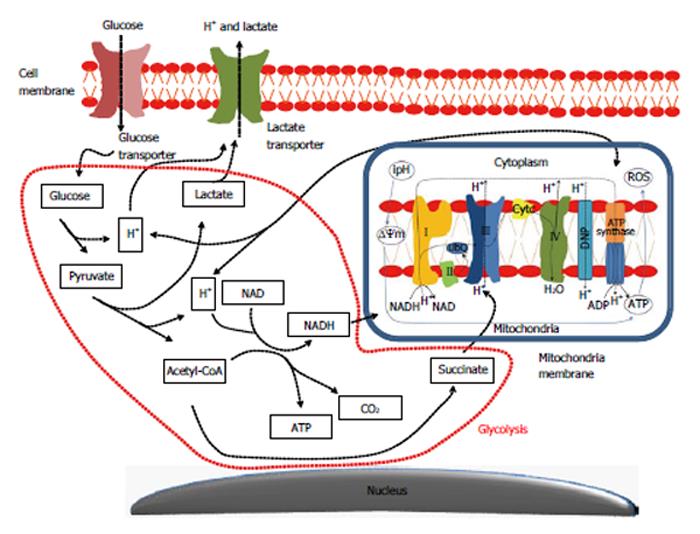Copyright
©2014 Baishideng Publishing Group Co.
World J Gastrointest Oncol. Jan 15, 2014; 6(1): 11-21
Published online Jan 15, 2014. doi: 10.4251/wjgo.v6.i1.11
Published online Jan 15, 2014. doi: 10.4251/wjgo.v6.i1.11
Figure 1 Main metabolic interactions lead to formation of the aerobic glycolytic metabolism in colon tumor cells.
The increased biosynthetic activity of cancer cells, as related to the activation of the aerobic glycolytic metabolism or “Warburg effect”, is based on the activation of glucose and lactate transporters supplying tumor cells not only with vast amounts of energy (glucose), but further reducing blockage-associated mechanisms due to glycolysis over usage. It seems that the lactate overproduction is compensated by the hyperactivation of lactate transporters allowing a rapid transport of this molecule across the plasma membrane together with H+ atoms, which results in an intracellular alkalinization. This event hyperpolarizes the mitochondrial membrane potential (ΔΨm) and induces a higher uptake of NADH by the first and succinate by the second mitochondrial complexes enhancing the oxidative mitochondrial phosphorylation (Krebs cycle). All together, this means that tumor cells are prone to produce higher energy amounts (ATP) than found in a normal tissue. ROS: Reactive oxygen species; CO2: Carbon dioxide; ipH: intracellular pH. NADH: Nicotinamide adenine dinucleotide phosphate-oxidase.
- Citation: Stopper H, Garcia SB, Waaga-Gasser AM, Kannen V. Antidepressant fluoxetine and its potential against colon tumors. World J Gastrointest Oncol 2014; 6(1): 11-21
- URL: https://www.wjgnet.com/1948-5204/full/v6/i1/11.htm
- DOI: https://dx.doi.org/10.4251/wjgo.v6.i1.11









